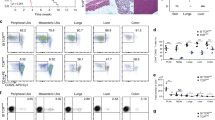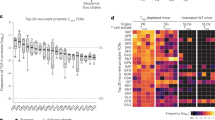Abstract
IN mice, immune effector functions mediated by thymus-derived lymphocytes (T cells) are restricted by the major histocompatibility (H–2) gene complex (see ref. 1 for review). Thus, virus-stimulated cytotoxic T cells are specific for both viral antigen(s) and self-cell-surface structures coded in the K or D region of H–2 (refs 2, 3). Two general hypotheses have been proposed to explain H–2 restriction2–5. First, T cells possess two independently, clonally expressed, but linked receptors, one for the foreign antigenic determinant and one for the relevant self-marker (dual receptor model); second, T cells have a single clonally distributed receptor for a complex of foreign antigen plus self or for virally altered self-markers (altered self model). To date no conclusive proof exists for one hypothesis or the other. The altered self model is the simpler concept of the two; on the other hand, the fact that cytolytic interactions against minor histocompatiblity antigens are H–2 restricted and that the idiotypic determinants of T cell-receptors are identical with those of immunoglobulins of the same specificity6–8 are probably more compatible with a dual receptor.
This is a preview of subscription content, access via your institution
Access options
Subscribe to this journal
Receive 51 print issues and online access
$199.00 per year
only $3.90 per issue
Buy this article
- Purchase on Springer Link
- Instant access to full article PDF
Prices may be subject to local taxes which are calculated during checkout
Similar content being viewed by others
References
Munro, A. & Bright, S. Nature 264, 145–152 (1976).
Zinkernagel, R. M. & Doherty, P. C. Nature 248, 701–702 (1974).
Blanden, R. V. et al. Nature 254, 269–270 (1975).
Doherty, P. C., Blanden, R. V. & Zinkernagel, R. M. Transplant. Rev. 29, 89–124 (1976).
Zinkernagel, R. M. & Doherty, P. C. Nature 251, 547–548 (1974); J. exp. Med. 141, 1427–1436 (1975).
Ramseier, H. R. & Lindenmann, J. Transplant. Rev. 10, 57–96 (1972).
Binz, H., Kimura, A. & Wigzell, H. Scand. J. Immun. 4, 413–420 (1975).
Eichmann, K. Immunogenetics 2, 491–506 (1975).
Pfizenmaier, K., Starzinski-Powitz, A., Rotd, H., Röllinghoff, M. & Wagner, H. J. exp. Med. 143, 599–604 (1976).
Zinkernagel, R. M. Nature 261, 139–141 (1976); J. exp. Med. 144, 933–945 (1976).
Von Boehmer, H. & Haas, W. Nature 261, 141–142 (1976).
Billingham, R. E., Brent, L. & Medawar, P. B. Phil. Trans. R. Soc. B 239, 357–375 (1956).
Klein, J. Biology of the Mouse Histocompatibility–2 Complex (Springer, Berlin, 1975).
Callahan, G. N., Ferrone, S., Poulik, M. D., Reisfeld, R. A. & Klein, J. J. Immun. 117, 1351–1355 (1976).
Author information
Authors and Affiliations
Rights and permissions
About this article
Cite this article
ZINKERNAGEL, R., CALLAHAN, G., STREILEIN, J. et al. Neonatally tolerant mice fail to react against virus-infected tolerated cells. Nature 266, 837–839 (1977). https://doi.org/10.1038/266837a0
Received:
Accepted:
Issue Date:
DOI: https://doi.org/10.1038/266837a0
This article is cited by
-
A one-receptor view of T-cell behaviour
Nature (1981)
-
Influence of the major histocompatibility complex on lymphocyte interactions in antibody formation
Nature (1978)
-
Cytotoxic T cells learn specificity for self H–2 during differentiation in the thymus
Nature (1978)
-
Spleen cells from animals neonatally tolerant to H-2Kk antigens recognize trinitrophenyl-modified H-2Kk spleen cells
Immunogenetics (1977)
Comments
By submitting a comment you agree to abide by our Terms and Community Guidelines. If you find something abusive or that does not comply with our terms or guidelines please flag it as inappropriate.



